Chapter 20
Floating and Sinking

Play with stuff in water to get a feel for Archimedes’s law.
Here’s a classic physics question we ask high school teachers in Timor. It involves a big rock in a boat that is floating on a small pond. A post stuck in the bottom of the pond extends up above the surface of the water, and the level of the pond can be seen on the post. The pilot of the boat picks up the rock and chucks it out of the boat into the pond. After the waves calm down, the pilot peeks at the post to check the level of water in the pond. What does she find?
- The water line went down, meaning the pond level decreased.
- The water line went up, meaning the pond level increased.
- The water line stayed the same.
And the answer is…C’mon, I’m not going to tell you the answer when you can do the experiment so easily with a couple of bottles and a rock!
Gather stuff
- Big bottle, top chopped off
- Small bottle, top chopped off
- Water, to fill the big bottle halfway
- A decent-sized rock that fits in the small bottle and doesn’t sink it
Gather tools
- Scissors
Tinker
Fill the big bottle half full. This represents the pond full of water.
Float the small bottle on the water in the big bottle, and then gently drop the rock into the small bottle. This represents the rock in the boat.
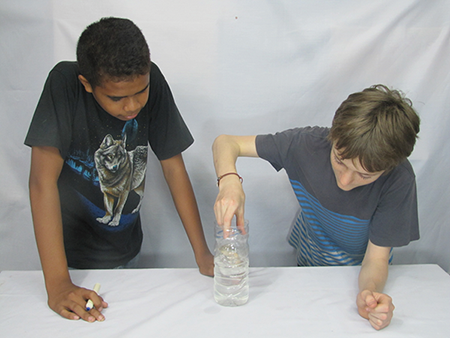
Mark the water level on the outside of the big bottle. This is the water level referred to in the question.

Also mark the water level on the outside of the small bottle. We noted this while it was floating but then had to take it out before marking it. This does not represent the water level in the question, but rather the water level on the side of the boat. That’s interesting, too, so it’s good to watch what happens to it as well.

Now take the small bottle out of the big bottle, careful not to drip any water outside the bounds of our ultra-high-precision scientific experiment; remove the rock; and drop it gently into the water in the big bottle—no splash.
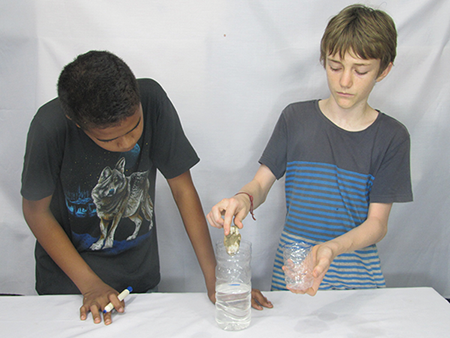
Drop the small bottle back into the water.

Check for change in water levels on the big and small bottles.

Any questions? The result is pretty obvious, eh?
Wait, you haven’t done it yet? Well, get up off your chair and go do it! You know the materials are waiting in your recycle container!
What’s Going On?
We do this activity as we’re dealing with Archimedes’s law, which tends to come up in textbooks:
- The buoyant force on a body in a fluid equals the weight of the displaced fluid.1
You may recall the great (and highly unlikely) story in which Archimedes was sitting in his bath, stark naked, circa 200 BC, pondering a challenge the king had given him: to prove his recently fabricated gold crown was not tainted with other metals. Watching the water he displaced rise on the side of the bathtub was the breakthrough moment for the venerable old thinker, and he leapt from the water and went running down the street, stark naked, shrieking “Eureka!”
What he’d realized in the fanciful story and what he wrote about in a treatise (which we do have pretty good evidence was his) was that you can calculate the volume of an irregular object by submerging it in water; the rise in water will be equal to the volume of the object. In our experiment then, when you drop the rock directly into the water, the water rises by a level equal to the volume of the rock.
But what about when it’s in the boat? In the boat, the rock can displace more water. Check this out: Anything floating in water is getting an upward force—buoyant force—equal to the force of gravity on it. Because these forces are balanced, it floats. If the force of gravity is greater than the buoyant force, the thing sinks. If the buoyant force is greater than gravity, the thing shoots up in the water.
For a floating object, these up and down forces are equal because the thing is displacing a weight of water equal to its own weight. Some part of the floating thing may be sticking up above the surface of water, but the part that is below water level has a volume equal to the volume of water it is displacing, which weighs the same as the entire object. Better reread that; it’s quite a concept.
Take an empty boat floating on the water:

The part of the boat under the surface is displacing a certain volume of water, and that volume of water weighs the same as the boat. There is some air and maybe some ropes and nets and suchlike inside the boat, all under the water level, but the material doesn’t matter here; it’s just the total volume of water displaced that matters.
Now toss in a pile of rocks:
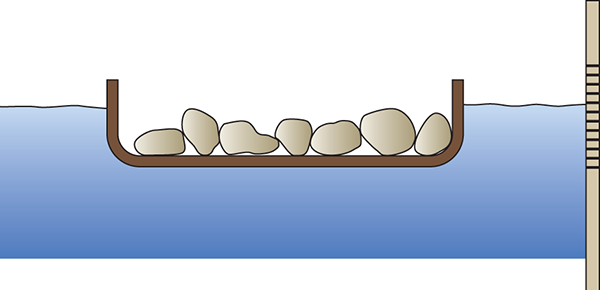
The part of the boat under the surface has increased so that the displaced water has increased, which makes sense because now that volume of displaced water has to weigh the same as the whole boat and the additional rocks.
Now pile in more rocks until the water is right up to the rim of the boat (called the gunwale in boating terms):

The boat has sunk down deep into the water and is now displacing its maximum. Still, the water displaced is of a weight equal to the boat plus the rocks.
Now toss in a few more rocks and watch in horror as the water flows over the gunwale into the boat and it sinks to the bottom of the sea.
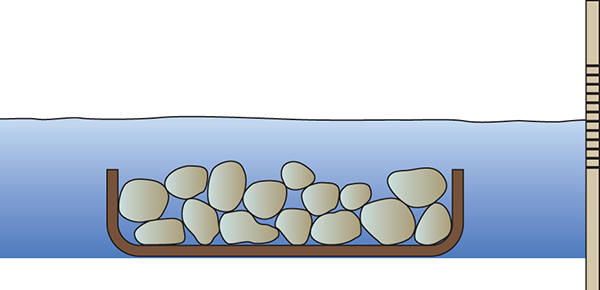
What happened? The boat had no more means to displace more water, and the weight of the water displaced was less than the weight of the boat plus all those rocks. Archimedes’s buoyant force depends on the weight of that displaced water, and since it’s now less than the weight of the boat and the rocks, gravity wins and pulls it under. (It does not depend on whether or not you’re naked.)
You can see that a bigger boat would have the capacity to displace more water and carry more rocks. The main point for our experiment is that being in a boat allows a rock to displace more water—in fact, to float—whereas without a boat the rock just sinks.
Meanwhile, the water rises in the pond according to how much water was displaced. So when it’s just the rocks, they displace less than when they are in the boat floating up at the surface. The water level on the post went down after the boat pilot chucked the rock into the drink.
To summarize, floating and sinking depend on two forces: buoyant force going up and gravity going down. Gravity depends on an object’s mass (and the earth’s mass, but we’re somewhat limited in our ability to change the earth’s mass or move to another planet for the experiment). Buoyancy depends on the displaced water, like old Archimedes said, which is determined by the object’s volume.
Another way to think about this is to imagine (or make…) two identical sealed bottles, one filled with sand and one filled with air. Under the water, they’ll displace the same, because they’re the same volume, and so will have the same buoyancy. But the one full of sand is much heavier, heavier than the buoyant force on it, so gravity wins and it sinks. The other is so light that it needs only a trifle of the total buoyant force possible, so it sinks into the water only a trifle and floats merrily on the waves.
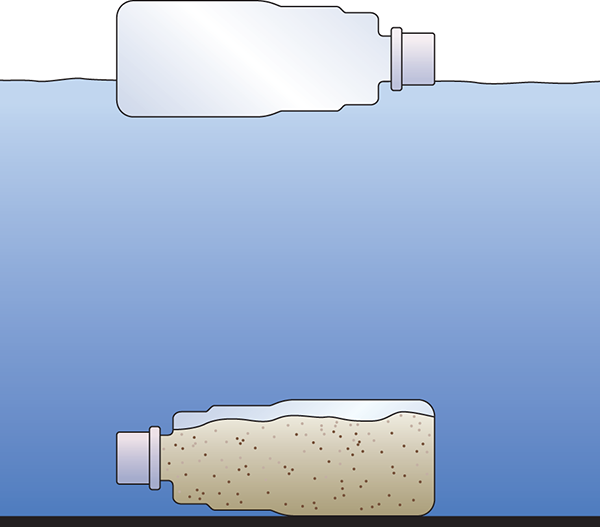
Now think of a small rock the same mass as that empty bottle. You could find one easily if you had a two-pan balance, or you could use a spring scale or any little scale. The bottle is much bigger than the little rock—that is, with a bigger volume, though the masses are the same. Chuck them both in the ocean, and you know which one will sink!2
So what determines if something floats or sinks? Well, it’s not the mass, and it’s not the volume; it’s both! That combination of mass and volume is so important it’s been given a name: density. When we say iron is heavy and Styrofoam is light, what we really mean is that iron is dense and Styrofoam is not. Of course a giant car-sized chunk of Styrofoam is going to be heavier than a little iron nail, but the iron is still the denser of the two. That is what makes it sink, even though it’s so small and light.
This is a concept that has serious consequences for Timorese fishers. Many small outrigger dugouts used in Timor don’t rise much at all from the water. If the fisher catches enough fish to fill the boat, or if a leak is sprung and the incoming water not bailed out in time, the boat will soon fill with water, and the boat will be displacing only the thickness of the tropical hardwood itself, at which point it is not so much a boat as a piece of driftwood with two outriggers and a worried pilot.
Balloons filled with helium and hot air also float, in air. Just like boats, the buoyant force on balloons depends on their total volume, and the net force they feel depends on the difference between their density and the density of the air they’re floating in.
Specifically, the buoyant force is a result of the difference in pressure above and below an object. Thanks to gravity, pressure decreases as you move up from the bottom of the ocean all the way to the top of the atmosphere. This pressure differential gives rise to buoyancy. Crazy, eh? Gravity pulls down and also makes fluids push lower density stuff up. If you ever make a boat, you’d better find a way to get its density lower than the water you hope to float on!
